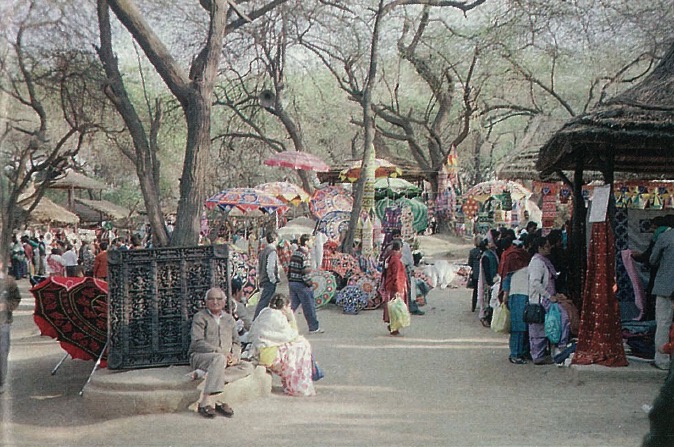By SHIKHA MALAVIYA, MINNESOTA
As our taxi rushes through the dusty streets of Delhi, my heart goes pitter patter. We are going to the fair! A fair my uncle describes as “a cultural kaleidoscope of music, dance and art.” Within minutes we cross the border, enter the state of Haryana, and pull into the small town of Surajkund. Colorful banners wave back and forth in the bright winter sky. We park our car along with a sea of others and follow the stream of people toward an intricately-carved wooden gate flanked by two turbanned men playing the tutuhi, traditional horn. The Surajkund mela beckons us in all its splendor.
The mela, or fair, spreads across a hilly terrain. Walking along its dusty paths, I feel as if I have entered a bustling village. Each year the mela has a theme which is represented by a state in India. This year Gujarat has the honors, and it has added to the mela’s village charm by designing a street replete with authentic havelis (village mansions) decorated with carved balustrades, antique wooden doors and embroidered wall hangings. People crowd around the havelis where craftsmen proudly display their goods. The woman in front of me furiously bargains for an ornate hand-embroidered bedsheet. “I will only give Rs250,” she avows. I smile knowingly as the craftsman gives in and says, “Okay. But only this time!” What is a crafts fair without a bargain?
Standing on a hill, I survey stalls disguised as thatched huts spilling over with everything from colorful Kashmiri shawls to marble statues. The mela, hosted by Haryana Tourism, began in 1987 to promote and expose the many arts and crafts of India. The Surajkund Mela Authority, a non-profit organization comprising the Union Ministry of Tourism, and the Development Commissioner of Handlooms and Handicrafts, is responsible for organizing the ever-successful event. With award-winning craftsmen bringing their wares from every part of India for the past eleven years, is it any surprise that word of the Surajkund mela has crossed the Indian Ocean? Jam-packed with tourists in the fifteen days that it runs, an estimated 20-40,000 people visit on an average day.
So how do they do it? The planning starts nine months in advance. First the theme state is decided. Past states have been Rajasthan (1989), West Bengal (1990), Kerala (1991), Madhya Pradesh (1992), Orissa (1993), Karnataka, (1994), Punjab (1995), and Himachal Pradesh (1996). Most states design an ornamental gate which is constructed at the entrance to the exhibition. Next, the participants are selected from a database which mela authorities update regularly. The selection process is critical, with each participant allowed to participate only three times and not more than two years in a row. This year, 76 national award winners and 22 state award winners filled the stalls, ensuring top quality and creativity.
A sample of the variety at Surajkund: Embroidery comprising Banjara “gypsy” and Bunni work in the form of bedsheets and cushion covers (Rajasthan and Gujarat); traditional Kantha work in the form of saris (West Bengal and Tripura); Chikan embroidery in the form of Salwar Kameez (Uttar Pradesh)…just to name a few. In woodwork, you’ll find a dazzling array of sandalwood, rosewood and cane from Punjab, South India and other states, carved into statues, plaques, tables, chairs, treasure chests and much more. And let’s not forget carpets: Punja dhurries from Haryana; wool carpets from Mirzapur and little rugs from Kashmir perfect for meditation! You’ll find oxidized jewelry, colorful wooden toys, temple paintings from Orissa….The list goes on and on.
Working through the maze of stalls, I suddenly find myself in front of the beautiful Maheshwar Devta gate. Walking further, I spot a group of men dressed in orange, their turban-clad heads moving from side to side. It is the Haryana Orchestra enthralling the crowd with their mystical music and snake-like dance. The Surajkund mela is well known for its folk theatre. In natyashala, an open-air theatre, dance and music groups perform throughout the day. Today it is a Rajasthani folk dance about Lord Krishna and His Gopis, who are getting back at Krishna for His naughty antics.
After two hours of scoping the fair, I spy a stall displaying beautiful tantric motifs. The craftsman has come from Ladakh to sell hand-painted scrolls with the eight symbols of good luck and dragons painted on wood. I bargain for both a scroll and a dragon painting. By now, it is dusk and the crowd is thinning. We arrive at the food stalls to be greeted by a welcome feast. The mouth-watering food from Punjab, South India and Gujarat would satisfy even the most discriminating palate.
By the time we finish our meal, Surajkund village is retiring in a blanket of darkness. Workers spray water on the dirt roads, getting ready for the thousands of soles that will trample these trails tomorrow. As we walk out the gate, my uncle looks at me with a glint in his eye and says, “So was I right? Have you seen anything like this before?” I smile and reply, “Sure I have… In storybooks!”
